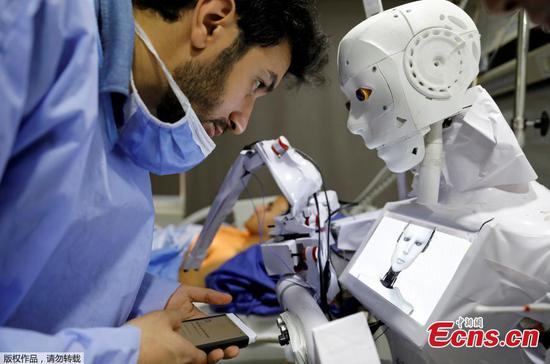
Staff members inspect equipment at a production workshop of Novo Nordisk (China) Pharmaceuticals on Feb 25. The parent company will invest $30.5 million to set up a new unit at the Lingang Special Area of the China (Shanghai) Pilot Free Trade Zone. (Photo/Xinhua)
China's economic resilience, policy supports, long-term strategy attract big-ticket investments
Tailwinds are not only offsetting the negative economic impact of COVID-19 on China's healthcare industry but also speeding up its evolution, heralding restructuring, expansion and rise in foreign investment flows, industry insiders said.
The glad tidings promise to make health one of society's top priorities as the nation swears by the new dual-circulation pattern for high-quality development in the post-pandemic era.
A confluence of several factors-growing demand for higher-quality healthcare, improved protection for intellectual property rights, deepening of China's reform and opening-up, reinforced commitment to globalization, a business-friendly environment, integration of cutting-edge technologies into the medical field, new agreements for regional trade and economic cooperation, and a long-term national health strategy-has created a near-perfect setting for the next big leap of the healthcare industry, they said.
To be sure, COVID-19 has caused massive job losses and a sharp fall in global foreign direct investment flows, but a quicker-than-expected economic recovery and remarkable resilience have made China one of the most attractive investment destinations in the global healthcare industry.
For instance, during the third China International Import Expo in early November in Shanghai, Novo Nordisk, a global healthcare leader in diabetes treatment, announced it will invest 200 million yuan ($30.5 million) to establish a new facility at the Lingang Special Area of the China (Shanghai) Pilot Free Trade Zone.
Novo Nordisk's new unit will foray into several market segments, including marketing, pharmaceutical research and development, and finished goods imports and distribution.
"The excellent business environment and preferential policy support in the Lingang Special Area will allow this new entity to become a powerful driver of Novo Nordisk's strategy of solidifying its value chain in China," the company said in a statement.
12Next >>|

Visitors check out information at the booth of Agilent at Analytica China, a global trade fair for laboratory technology, analysis, biotechnology and diagnostics, in Shanghai on Nov 17, 2020. [Photo/China Daily]
Experts said China's healthcare market is important for foreign investors due to its massive size and new business opportunities arising from the ever-deepening reform and opening-up.
The government's efforts over the years to meet people's growing demand for higher-quality healthcare services and products also brightened the prospects of the healthcare market, said Shi Lichen, founder of medical consulting firm Beijing Dingchen Consultancy.
China will continue to promote the "Healthy China 2030" initiative, to safeguard people's health. It will heighten its emphasis on disease prevention and supplies of all-around full-cycle health services, according to the Party leadership's proposals for formulating the 14th Five-Year Plan (2021-25) for National Economic and Social Development and the Long-Range Objectives Through the Year 2035, unveiled on Nov 3.
Specific objectives include enhancing public health protection, improving the disease prevention system, deepening the reform of the medical and healthcare system, rebalancing medical resources, pushing forward development of high-end medical devices, promoting telemedicine, highlighting mental health services, and accelerating development of the healthcare industry.
During the 13th Five-Year Plan period (2016-20), Chinese pharmaceutical companies, especially biotech firms, have been actively developing cutting-edge treatments, thanks to the supportive environment created by the country's unprecedented medical industry regulatory reforms starting 2015.
With emphasis on medicine efficacy, safety and quality, the ongoing reforms have encouraged innovation, sped up registration of clinical trials and new drugs, helped improve the quality of domestic generics and cut drug prices, and so forth.
According to Hangzhou, Zhejiang province-based Hsmap, a big data platform with focus on medical innovation and entrepreneurship, domestic developers' investigational new drug, or IND, applications and new drug applications, or NDAs, for Class 1 new chemical drugs, or those that have never been marketed in China or overseas, have surged during the 13th FYP period.
Domestic developers' IND applications and NDAs for Class 1 new chemical drugs were 220 and 5 in 2016, while in 2019, the two figures rose to 381 and 19 respectively. This year, by May 20, the two figures reached 183 and 6.
Although no reliable data are available yet on FDI inflows into China's healthcare sector this year, China is said to have bucked the sharp downturn in global FDI caused by the pandemic, according to a new report by the United Nations Conference on Trade and Development.
Global FDI fell by 49 percent to $399 billion in the first half of this year. But, FDI flows into China were relatively stable at $76 billion during the period, the report said.
Kang Wei, managing director of the R&D-based Pharmaceutical Association Committee, observed that foreign pharmaceutical companies have been stepping up investments in China due to the country's continuously enhanced business environment and new policy measures rolled out one after another to encourage innovation.
Data from the RDPAC, which is part of the China Association of Enterprises with Foreign Investment, showed its 42 member companies already had 47 factories and 25 R&D centers on the Chinese mainland by the end of June.
Member companies of the RDPAC had launched more than 206 innovative drugs in the China market from July 2015 to June 2020.
In 2019 alone, investments from those companies on R&D on the Chinese mainland reached about 12.2 billion yuan.
Apart from the investment plan in Lingang, Novo Nordisk announced a 2.0 version of its "China Essentials" program.
The first version was announced in April. Its guideline is to integrate China into Novo Nordisk's global clinical development program and achieve simultaneous submission for global new drug applications.
The new version further commits to working with China's pharmaceutical innovation drivers to improve local innovation and R&D capabilities, and improve the ability of local companies to transform research into results.
By the end of 2021, Novo Nordisk will establish comprehensive strategic partnerships with 20 hospitals across China to build bases for clinical trials.
At the same time, it will expand its diabetes and hemophilia research funds, and continue to create a high-end international academic communication platform through the Novo Nordisk's Young Scientific Talent Development Program.
Christine Zhou, senior vice-president of Novo Nordisk and president of its China arm, said the company is confident of its promising future in China, especially as China has become the first major economy reporting a fast rebound after it controlled the spread of COVID-19 effectively.
"The Chinese economy shows strong resilience and great potential, and the country's resolute efforts in intellectual property rights protection and deepening opening-up and reforms, together with its support for globalization, have combined to improve its business environment," Zhou said.
"The deepening of reforms in the healthcare sector has been creating unprecedented opportunities for pharmaceutical companies, making China one of the most attractive healthcare markets in the world for multinational companies."
The company is leveraging cutting-edge technologies to explore digital R&D, with plans for long-term cooperation on big data and artificial intelligence technologies with the Department of Biostatistics at Peking University's School of Public Health and the Beijing International Center for Mathematical Research.
Mike McMullen, president and CEO of the US-based Agilent Technologies, said a business-friendly environment is one of the major reasons for the company's extensive investments in China for research, solutions and services.
China's 13th Five-Year Plan (2016-20) and the "Healthy China 2030" initiative provide significant opportunities for Agilent, and based on the plan, Agilent has for the first time prepared its own country-level five-year plan for China, its biggest single-country market outside of the US that contributes over 20 percent of total annual revenue, he said.
The company's long-term strategy is very closely aligned with China's road map for healthcare. The company will continuously monitor China's dual-circulation development pattern as it develops its own new country-level five-year plan.
"For a country with a population of 1.4 billion, health conditions are a top priority in China. This brings huge market opportunities for Agilent as a leading company in the country," he said.
"We are very aware of the new concept of 'dual-circulation' and believe it will become the theme for the upcoming 14th FYP (five-year plan)."
Apart from the size of commercial opportunity, the dramatic transformation of the Chinese economy to become increasingly innovation-driven and a leader in drug development and various types of investment in the biopharma area, and improvements in the environment and food safety, have all encouraged the company to make continuous investments in China, he said.
Servier China, a subsidiary of French pharmaceutical giant Servier, has also been stepping up investments in China, especially in digital health and biopharma innovation.
Servier established its BioInnovation Department in China as well as the US in 2018, focusing on preclinical and early clinical innovation.
At the first Servier BioInnovation Seminar, which was held during the third CIIE, Stephane Mascarau, general manager of Servier China, said that the company looks forward to collaborating with the best of Chinese biotech innovators to promote the translation of biomedical technologies and clinical research capabilities, and provide better healthcare to Chinese patients.
The company's WeHealth Digital Medicine program, launched in 2016, has been building an incubation platform based on major innovation centers and startup databases in China, to select startups with the same idea, superior technology and high-potential products through promotional tours and negotiations, to provide them with comprehensive support.
Zhou Gaobo, partner at management consultancy McKinsey &Company, said various types of collaborations are growing, not just at the asset level or for commercialization but sometimes for sharing of technology platforms, making China's healthcare market vibrant.
"That is a very important driver of success and growth in the industry," he said.
|<


















































